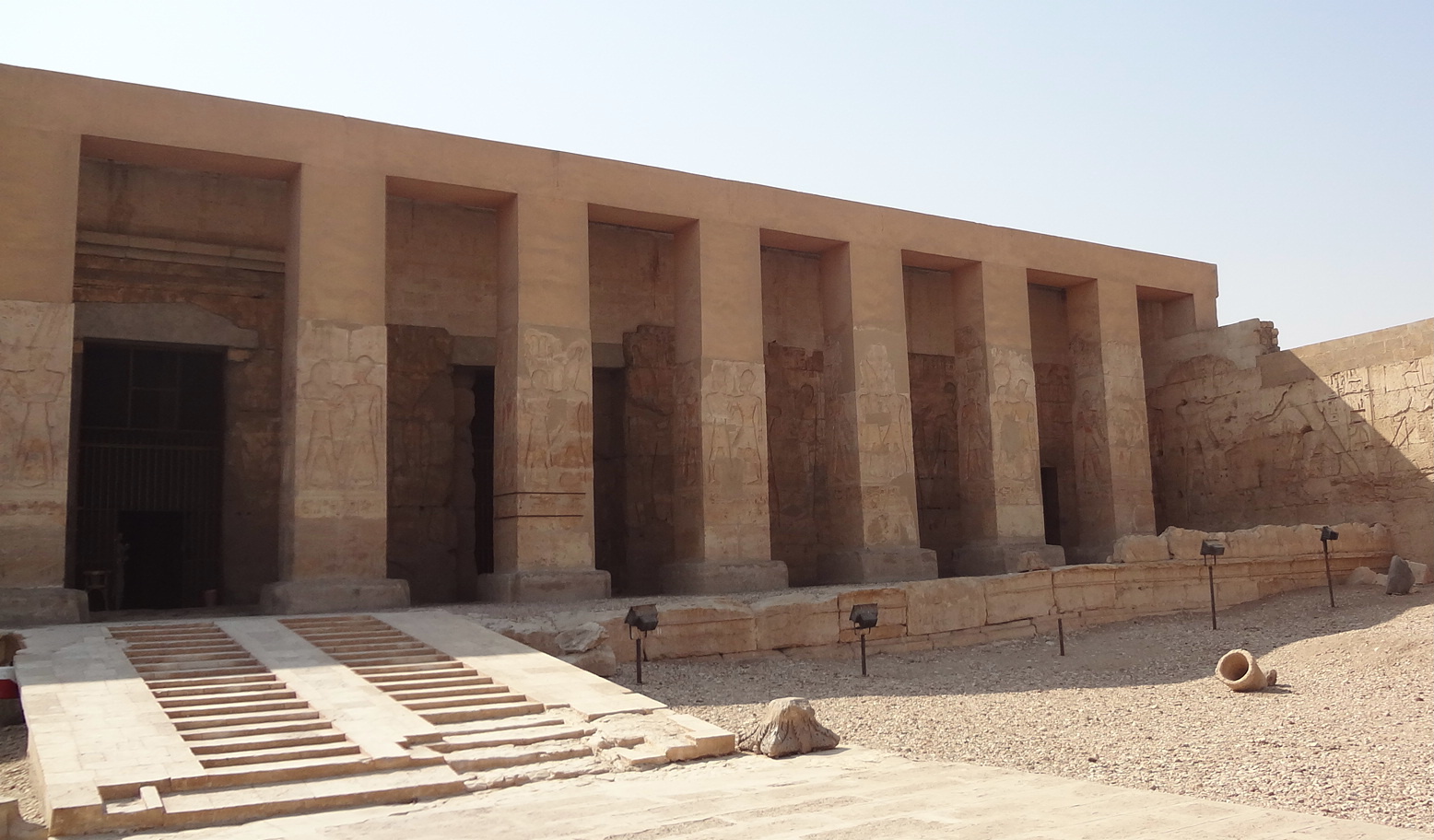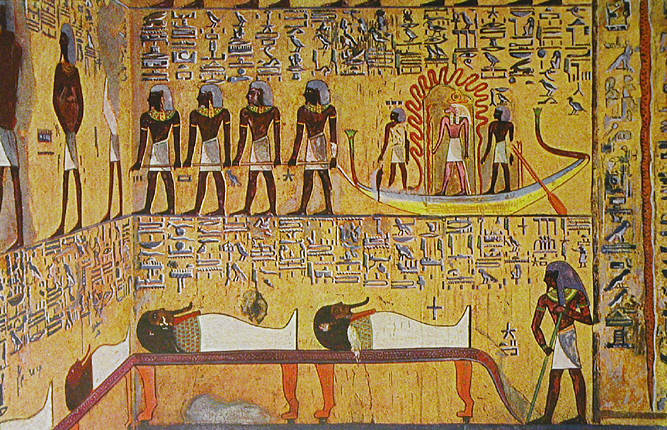Abydos
Abydos has been used as a burial site and sacred site since predynastic history, It was originally sacred to jackal-headed god Wepwawet, who “opened way” to realm of dead. Anhur appeared in XI Dynasty at Abydos; Anubis rose importance in Middle Kingdom vanished the XVIII Dynasty.
The worship of Osiris in various forms appeared that Abydos in XXII Dynasty and became increasingly important, until the entire site was considered sacred primarily to him by XIX Dynasty.
The Temple of Seti I at Abydos was begun during the reign of Pharoah Seti I (1318-1304 BC) and completed son Ramses II (1304-1237 BC) during these XIX Dynasty of New Kingdom. The temple represents artistic revival of Old Kingdom forms and was part of Seti’s attempt to consolidate the Ramessid dynasty after the losses under Akhenaten.
By identifying himself with that great gods and previous rulers of Egypt, Seti added legitmacy to ruling family had mere warriors just few generations ago.

Pharaoh Merneptah added a great Hypogeum of Osiris to temple of Seti. The final building to add was Temple of Nectanebo I in XXX dynasty, but various additions to site were made the Ptolemaic and Roman periods.
Thanks to impressive carvings, the Temple of Seti I has been a tourist attraction since the 1830s.
Abydos began to excavated in early 20th century by Flinders Petrie and excavations still continue today.
Abydos
In more recent times, Abydos was home of New Age practitioner Dorothy Eady from 1946 until her death in 1981. Mrs. Eady believed herself to reincarnation of Abydos temple priestess and lover of Seti I, was known as Umm Seti (Mother of Seti), experienced trances and uttered prophecies.
More details can had in her book Abydos: The Holy City in Ancient Egypt and the biography by Jonathan Cott, The Search for Omm Sety.
What to See

The site of Abydos is huge, and includes a number of ruins and mounds around the edge of desert.
Most visitors, however, stick to grand Temple of Seti I because of time and police restrictions.
The Temple of Seti has unusual L-shaped layout and multiple sanctuaries, but other wise incorporates the elements common to Egyptian temples.
Entrance is north side, where the pylon and forecourt are mostly destroyed but still contain some partial reliefs (such as Ramses II defeating enemies at Qadesh, on left side of forecourt).
Stairs lead from forecourt the upper second court, where damaged statues are displayed. Overlooking the second court is facade with square pillars covered with reliefs of Ramses II greeting Osiris, Isis and Horus.
The upper part of facade has been rebuilt in concrete.
The Outer Hypostyle Hall contains sunk-reliefs completed by Ramses II after Seti’s death. They are not very impressive, suggesting that Ramses redeployed Seti’s best craftsmen to work on his own temple, the Ramesseum.
On the entrance wall, Ramses measures the temple with the goddess Selket and presents it to Horus.
On the right wall, Ramses offers a falcon-headed box of papyrus to Isis, Horus and Osiris and is led to temple by Horus and the jackal-headed Wepwawet to anointed with holy water (represented by interlinked ankhs).
Abydos
One of the roof lintels in Outer Hypostyle Hall bears cartouche has become famous for including the so-called “Abydos helicopter.” Internet theorists hold that ancient engraving shows helicopter and submarine; archaeologists disagree and explain the unusual shape as resulting from erosion and the layering of one cartouche over another.
The Inner Hypostyle Hall, made of sandstone on east and west sides and limestone the north and south, was last part to decorated before Seti’s death.
Some sections remain incomplete, but the reliefs that were finished are excellent.

On the right wall, Osiris and Horus prou holy water from garlanded vases over Seti, who makes offerings before the shrine of Osiris.
Osiris is attended by Maat and Ronpet (goddess of the year) in front and Isis,
Amentet (goddess of west) and Nephthys in back. Seti’s profile bears close likeness to his mummy, which is display in Cairo Antiquities Museum.
The reliefs on back wall are still brightly colored, and show Seti being anointed and crowned by gods.
An especially notable section is high on the left, between the sanctuaries of Ptah and Re-Herakhte, with Seti kneeling before Osiris and Horus with the sacred persea tree in back ground.
Two projecting piers on side walls near the back of hall show Seti worshipping the Djed column while wearing the combined crown of Upper and Lower Egypt.
Behind the Inner Hypostyle Hall are seven sanctuaries, which contain the best reliefs in temple.
From left, the small sanctuaries are dedicated to Seti I, Ptah, Re-Herakhte, Amun, Osiris, Isis and Horus.
Each one is roofed with false vaults carved from rectangular slabs and end in false doors (except for Osiris’ sanctuary, which has real door to his inner sanctuaries).
The reliefs in Sanctuary of Seti emphasize the pharaoh’s recognition by gods, who are shown leading him into the temple and ceremonially uniting the Two Lands (Upper and Lower Egypt) along the northern wall.
Near the back of the left wall, Seti receives a list of offerings from Thoth and leopardskin-wearing High Priest Iunmutef.
Seti is lastly shown leaving the temple on a palanquin borne by jackal-headed (from Upper Egypt) and hawk-headed (from Lower Egypt) deities.
Behind the seven sanctuaries are the inner sanctuaries of Osiris, with three side chapels dedicated to Isis, Seti and Horus respectively.
The reliefs in chapels retain much of bright colors, but have been blackened by mold in last few decades.
The portal nearest Seti’s sanctuary leads into the columned Hall of Sokar and Nerfertum (deities of north representing the cycle of death and rebirth, who were integrated into the cult of Osiris) in southern wing of temple.
Reliefs include Seti receiving Sokar
(with hawk’s head) and Nefertum (in human and lion form, crowned with a lotus blossom).
In the Chapel of Sokar, Osiris returns to life grasping his phallus, while Isis hovers over him in hawk on opposite wall.
The Chapel of Nerfertum requires flashlight to see anything in.
Another portal a little further from Seti’s sanctuary leads into the Gallery of Kings, named the list of Seti’s predecessors carved into the right wall.

Hatshepsut and Akhenaten (with his heirs) are omitted from list in accordance with custom, and Seti’s own name is listed as Menmare Osiris-Merneptah instead of Menmare Seti-Merneptah in order to distance himself from Seth (a.k.a. Seti), the enemy of Osiris.
Seti and Ramses II are depicted facing the list, which has proved very useful to archaeologists and historians.
The Gallery of Kings, a side corridor leads past a relief of Seti and Ramses harnessing a bull and running to greet Wepwawet. From here, a rear door leads behind the temple to Osireion, the cenotaph or “dummy tomb” of Seti I.
Osireions did not contain pharaohs’ mummies but were intended to promote a close association between the pharaoh’s ka and Osiris.
Seti’s is only one of these now visible, but is still half-buried and partly inaccessible by stagnant water.
The Osireion is made of massive blocks and encloses a room that once contained a mound surrounded by a moat, symbolizing the primal mound that arose from waters of Chaos at dawn of Creation, and an empty sarcophagus.
About 300m northwest of the Temple of Seti I is the ruined Temple of Ramses II.
Fragments of reliefs showing the Battle of Qadesh survive on the enclosure walls and pillared courtyard.
Abydos Getting There
Most people visit Abydos as day trip from Luxor, usually in conjunction with Dendera on the way.
The trip can arranged by coach through various tour agencies, such as Private Tour to Dendara and Abydos for $49/person.
Alternatively, you can take a five-seater taxi (£E275), eight-seater microbus (£E475), or a 12-seater minibus (£E1100). (Prices are total for group, round trip, and include a stop in Dendera.) Some Luxor hotels like Happy Land will take 3-4 people to Abydos for £E225-250 total.
The more adventurous can travel by bus (11:15 or 1:15) or train to El-Balyana, which is 10km from Abydos.
A local taxi from El-Balyana to Abydos is about £E20 one-way. Not all trains stop at El-Balyana and the unofficial rule for buses can’t more than four tourists aboard at one time, so arrive early.
Abydos Quick Facts
Site Information
Names: Abydos; Abydos; أبيدوس (Arabic); Αβυδος (Greek); Temple of Seti I; Great Temple of Abydos
Location: Upper Egypt, Egypt
Faiths: Original/Primary: Ancient Egyptian
Current/Secondary: New Age
Dedication: Seti I, Osiris, and other gods
Category: Egyptian temples
Architecture: Egyptian
Date: c.1300 BC (New Kingdom, XIX Dynasty)
Patron(s): Seti I and Ramses II
Features: Holiest
Status: ruins
Visitor Information
Address: Near al-Balyana, Nile Valley, north of Dendera in Upper Egypt
Coordinates: 26.184778° N, 31.91907° E (view on Google Maps)
Lodging: View hotels near this location.


